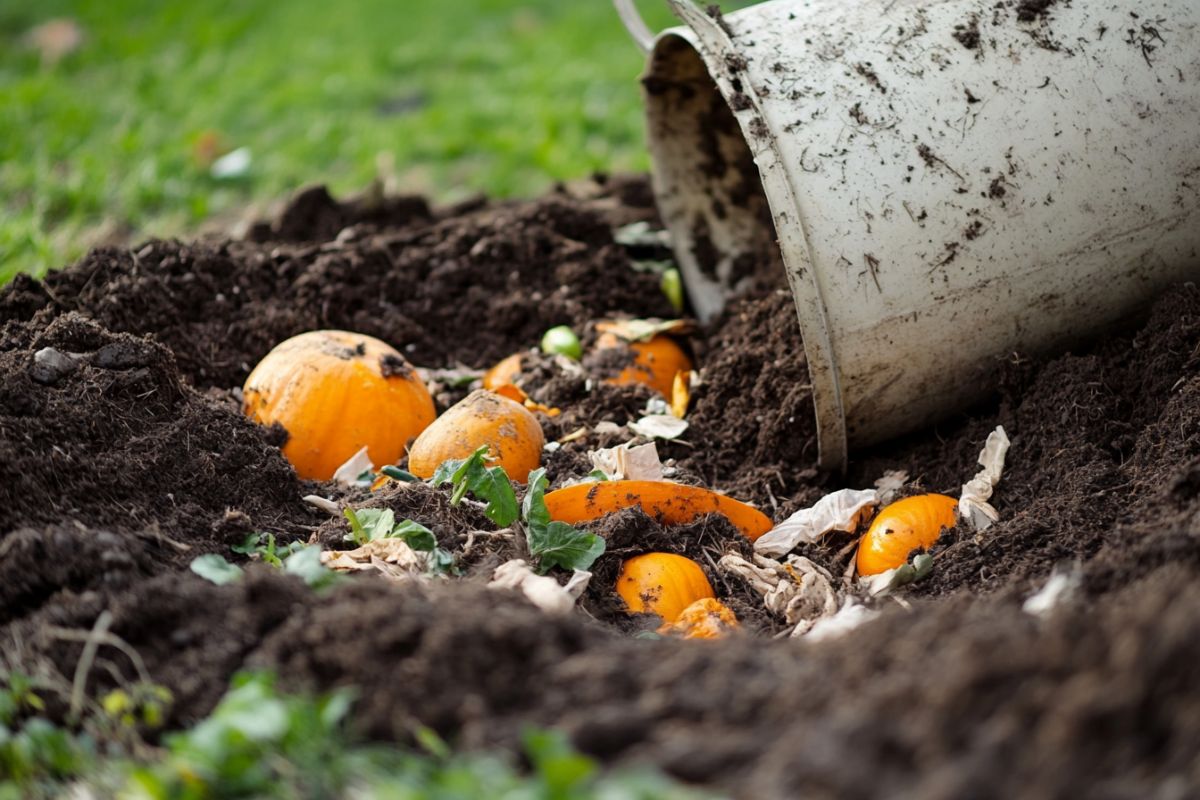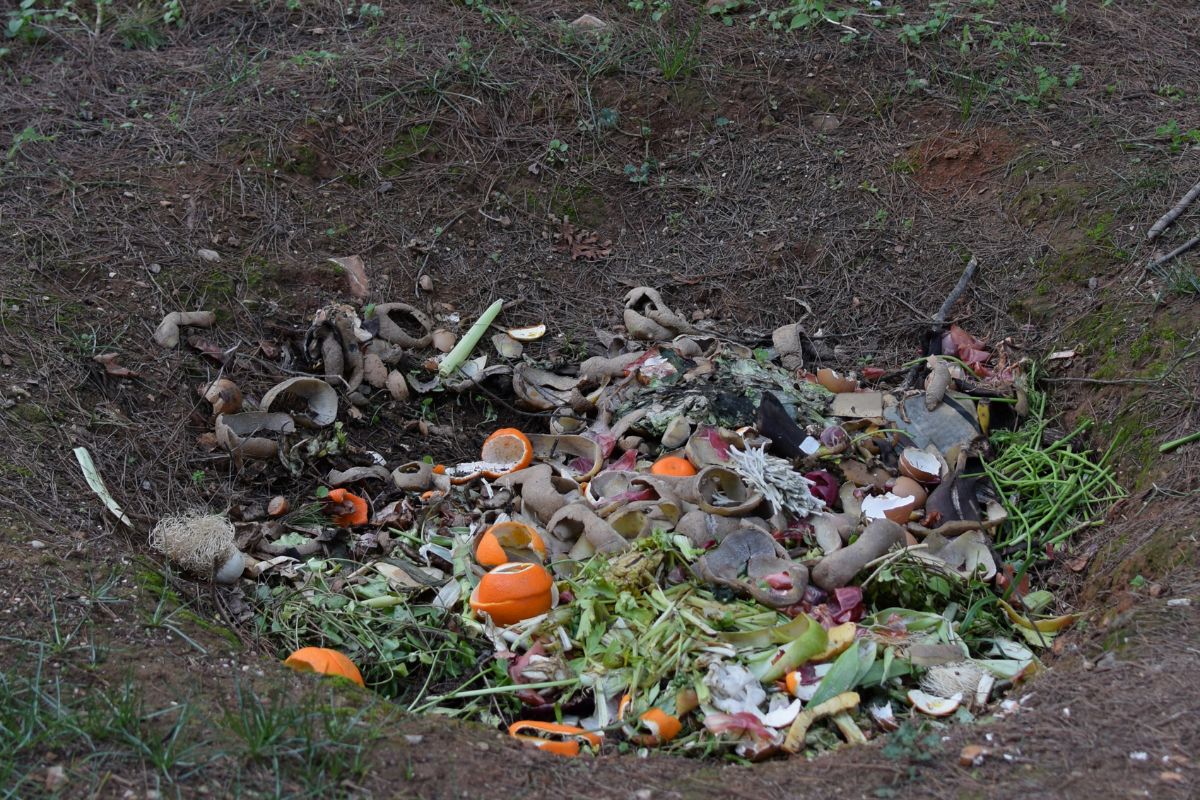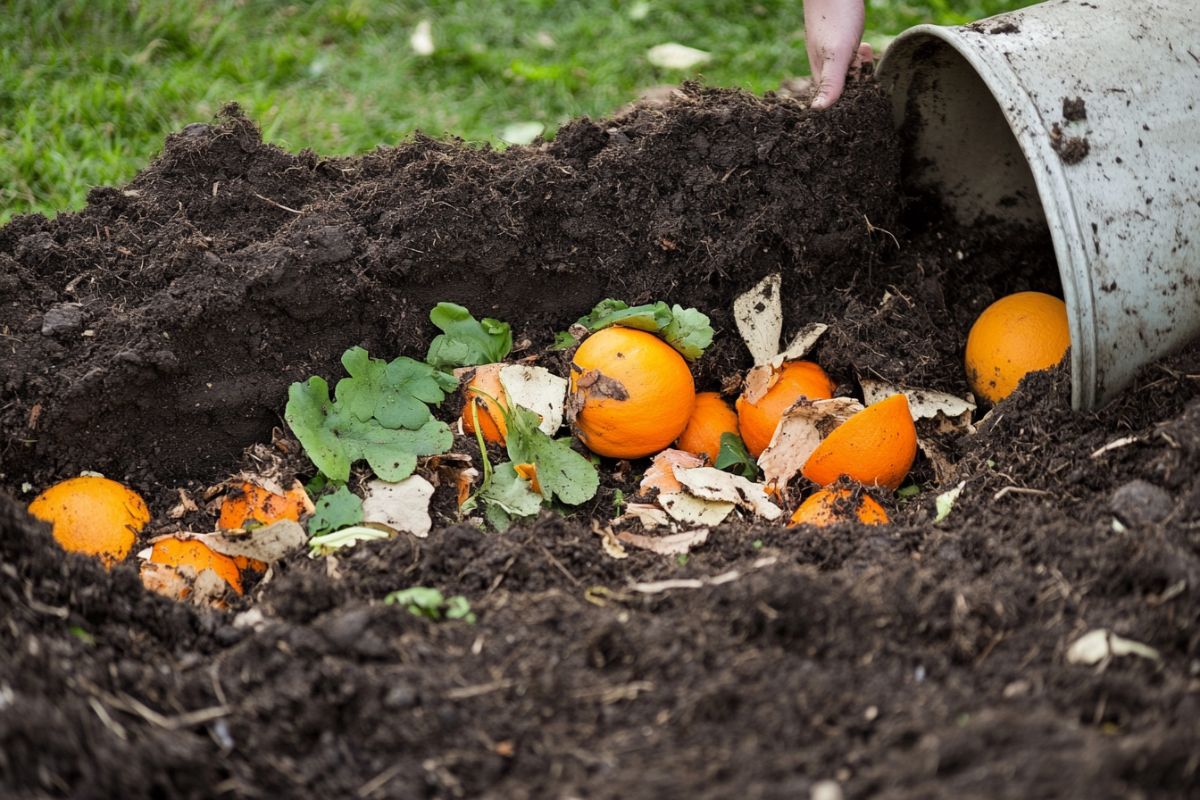While the principle of composting always remains the same – letting organic waste break down to become fertile soil – the methods vary considerably.
There are lots of different composting methods, both traditional and new. One of the many methods you will encounter when researching composting methods is in-ground composting, also known as Dig and Drop composting.
In this article, I will go into depth about in-ground composting, how to do it, what its benefits are, and how it differs from the traditional compost pile.
What is In-Ground Composting?

The in-ground composting method is pretty self-explanatory, compost in the ground. Similar to trench composting, you dig a hole in the ground to put your compost in to use this method.
In-ground composting works the same way as a compost heap, except there is no need to turn the compost. You also won’t have to transport your finished compost anywhere.
The process is simple. To start in-ground composting, dig a hole in your garden. Start to collect your food scraps and garden waste, and add it to the hole.
Each time you put in a layer of green material, add some brown material, or put a layer of soil over the top. When you have filled the hole, simply dig another and start again.
No harvesting is needed as the surrounding soil will absorb nutrients from the broken down kitchen scraps, coffee grounds, fresh grass clippings, and other compostable materials you’ve buried.
By digging into the ground and adding organic material, you are changing the structure, texture, and composition of the soil while providing essential nutrients.
Benefits of In-Ground Composting

There are many advantages to in-ground composting. Here is a list of the key benefits of in-ground composting:
1. It’s Low Maintenance
In-ground composting is probably one of the easiest and low maintenance forms of composting. All you need is a spade to dig the hole.
Unlike traditional compost heaps, there is no need to turn the compost, harvest the compost, or move it to other areas of the garden to use.
As this is a cold composting method, you won’t need to worry about nitrogen or carbon levels, or if your pile is too hot or cold. Instead, you can just fill the hole with organic materials to decompose, and leave it to allow plants to absorb the nutrients.
You won’t need to worry about the green to brown ratio either, as you will be filling the hole in with the dirt you dug out, so the soil will add moisture to brown materials and absorb it from green compost materials.
2. Cost-Effective
You won’t need to buy any materials to start in-ground composting, and you won’t have to construct anything. The only thing you’ll spend is time digging the initial hole!
3. Great for Crop Rotation
If you are growing your own vegetables and you have the space, I definitely recommend in-ground composting. Rotating in-ground compost holes with crops will give your crops and gardens extra benefits.
By in-ground composting in one area of your garden at the end of the growing season, you can just fill in the holes with food waste and other composting material. That area will be perfect for growing heavy feeders like tomatoes or squash in the following season.
Then rotate your crops, leaving a new patch free for in-ground composting. This system reduces the need for fertilizer and makes your job a little easier!
4. Your Soil Structure Will Improve
Unlike traditional composting, where compost is dug into the top layer of the soil, in-ground composting adds compost to the deeper soil layers.
As organic materials are added to a deeper layer of soil, in-ground composting can vastly improve your soil structure.
5. The Quantity of Organic Material Isn’t an Issue
As you are just digging a hole or trench to accommodate your waste, you don’t need to worry about having too much or too little.
You can dig small holes for a few vegetable peelings or a trench large enough to handle vast amounts of garden waste.
6. It Encourages Worms To Your Soil
Worms are an essential part of gardening, because they aerate the soil in your garden and help break down the organic matter in your compost.
By using the in-ground composting method, you will keep your worms in the soil so they can both aerate and leave theirworm castings in the soil. This will improve the overall quality of your soil, not just the area in which you are composting.
7. Great if You Want to Plant Trees or Shrubs
If you plan to plant a fruit tree or shrub, dig a hole about three to six months before getting the plant. You can then use this as an in-ground compost hole and add organic material to mix with the soil.
When it is time to plant your tree or shrub, you will have lovely, rich soil to plant it in and plenty of nutrients to feed the young plant.
In-Ground Composting vs. Traditional Composting

Traditional above-ground composting differs in many ways to in-ground composting, and there are advantages and disadvantages to both.
Above, I’ve listed the benefits of in-ground compared to above-ground composting, so let’s look at some of the drawbacks in comparison.
You will need more space for in-ground composting. Traditional methods require having a dedicated space for the compost pile. With in-ground composting, you will need to dig fresh holes as you fill the old ones. While this is good if you have a vegetable patch, grow annual plants, or like to plant a lot of trees, it is not ideal if you have a small yard with grass or perennials.
The finished compost is only available to use in the area where you buried the kitchen waste and other materials. You won’t have extra compost to use elsewhere.
As I’ve listed in the advantages, with in-ground composting, you won’t need to dig up your compost to use in your garden. However, you also won’t have a supply of useable compost for potting mixes if you grow potted plants.
Traditional composting is preferable for versatility as you can use it for mulch, compost tea, potting mixes, and greenhouses.
In-Ground Composting Final Thoughts
If you want to try in-ground composting, but are put off by the space and versatility issues, then check out some of the commercial in-ground compost bins are available.
If you think a hole in the ground filled with rotting organic waste might be an eyesore in your garden, or if you don’t have the space to keep digging holes, I recommend the VIVOSUN Outdoor Tumbling Composter.
The Subpod compost bin doubles up as a garden seat. It is better than both above and in-ground methods in many ways as it stores your compost away neatly and won’t stand out in your garden. If you have a small yard and want to compost, this bin is perfect.
Whether you go for traditional or in-ground composting depends on your situation and requirements. I hope this article has given you some helpful information on if in-ground composting is right for you.
For more composting articles, check out these articles:
In-Ground Composting FAQs
Can you make compost in a hole in the ground?
Yes, you can make compost in a hole in the ground. This composting method is called either In-Ground Composting or Dig and Drop Composting. Trench composting is another method of putting compost in the ground, with the exception that you dig a long trench.
How long does it take to compost in ground?
You can compost in the ground in as little as 2-3 months, but it can also take up to 12 months or longer. It depends on what materials you bury to compost and the size of your in-ground compost pile. Adding worms to the compost can help with aeration and speeding up the decomposition process.
How long does it take buried compost to decompose?
Buried compost will usually take two to six months to decompose if it’s mostly food sraps that buried. Times will differ depending on how much food waste you add, the temperature, moisture level, and what kind of worms you have and how many.
How long does compost last in the ground?
Compost in the ground will last indefinitely. Since compost is meant to be mixed with soil and the compost is already in the ground, you don’t need to worry about compost going bad or expiring. When compost is finished decomposing, it’s at its best for the next 3-4 months with nutrients. But because it’s already buried in the ground, there’s no concern for expiration.
How to dig and drop compost?
Digging and dropping compost is a simple process that involves digging holes in the ground and filling them with organic matter. Digging holes is done by hand or using a shovel. Once the hole is dug, fill it with organic matter such as grass clippings, food scraps, leaves, manure, straw, etc. Then cover the hole with dirt.
Does In-Ground Composting Attract Ants And Rodents?
In-ground composting can attract some ants, but rats are much less likely because the organic matter is buried 10-12 inches dep in the ground. Always have at least 4-5 inches of soil covering the compost or you’ll have rodents like raccoons and rats digging up the kitchen scraps. Ants may still get down into the dirt, but not as much as traditional above-ground compost piles.


